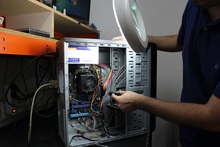Determining a Unit's Condition
Several MainBoss users have suggested that we give MainBoss the ability to track the condition of a unit. For example, one customer suggested that every unit record should have a "grade" field where you could rank units on a scale of 1 to 10. 10 might indicate that the unit was in excellent condition while 1 would mean "should be replaced immediately".
We could easily introduce such a feature, but how useful would it really be? Is it really that easy to rank unit's on a scale of 1 to 10? Would it be easier if we simplified this to a smaller set of possibilities, such as POOR, FAIR, GOOD, EXCELLENT? And if a unit is ranked as FAIR, how can you tell what that means? The specific details would surely vary from unit to unit: different types of equipment will obviously be judged by different criteria.
Still, there are obviously times when it's useful to record and track information about the quality of a unit. Here are some ways to do that.
Number of Work Orders
One simple measure of a unit's condition is the number of work orders recently performed on that unit. A unit that needs lots of work is often a unit that's in bad shape. As a quick way to determine the number of work orders against each unit, use the Work Order Summary report grouped by unit category, then unit; sort according to Work Orders and in the Advanced section, checkmark "Summary Format".
The resulting report tells you the number of work orders associated with each unit. Since the report is grouped by unit category, you can easily compare the units within a particular category to see if any have required a lot more work than the rest.
In many cases, you'll only want to look at corrective work orders—actual repairs as opposed to planned preventive maintenance. To do that, go to the Filtering section and specify the filter "Is Preventive: False". (Checkmark "Is Preventive", then specify "False" in the resulting box.) You might also blank out the "Show only active" records option, so that you see work orders over a longer range of dates than normal.
Using Specification Forms
Counting work orders is quick and easy, but doesn't give you detailed information. To collect such information, you can use specification forms that record condition-related data on different types of units.
For example, suppose your organization owns several vehicles. You could create a specification form that let you record condition-related data like this:
Thickness of brake linings:
Front right: _____
Front left: _____
Back right: _____
Back left: _____
Rust patches observed: ____________________________________________________
Known dents and scratches: ________________________________________________
Obviously, you could add more fields to this list: some might provide "hard" data (such as emissions readings) while others may be more qualitative (such as a mechanic's assessment of the vehicle's condition on a scale of 1 to 10).
By providing a form for recording such data, and by keeping it up to date, you can make it easy to assess and compare the conditions of the units that you maintain. For more on specification forms, see Specification Forms in our online documentation.




